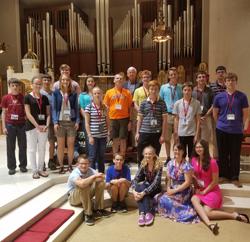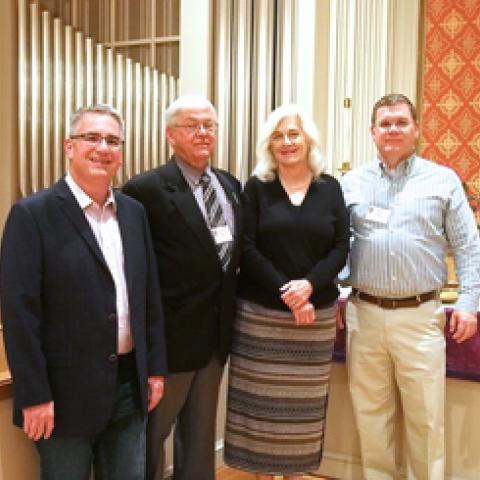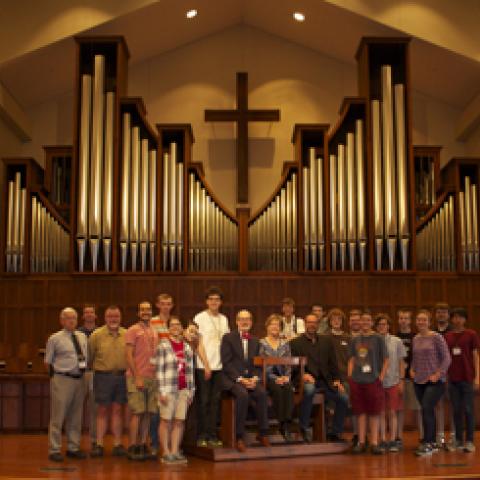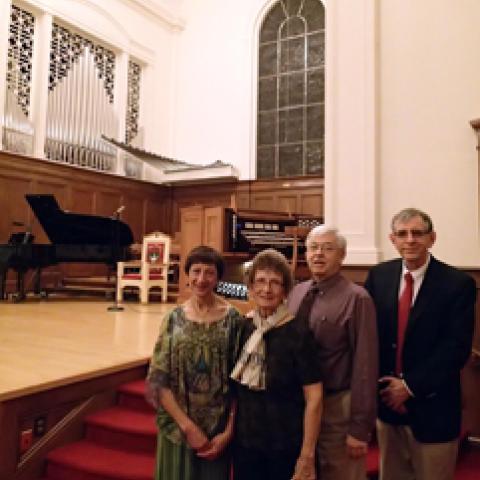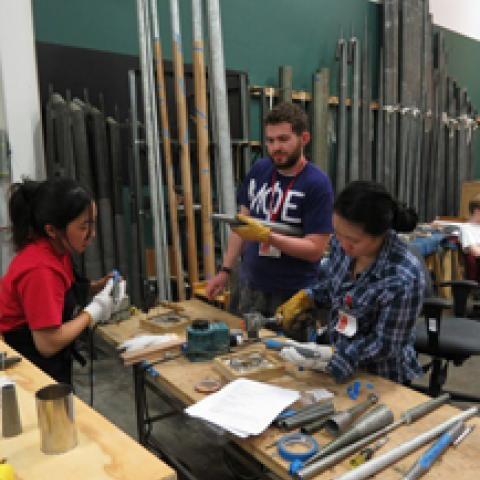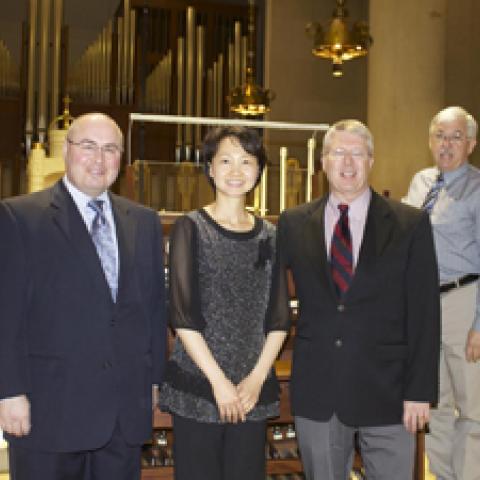Our new organ for the Cathedral of Christ the King closely follows the concept we have recently espoused for ideal three-manual design in an organ of moderate size, affordable for many situations. The concept includes:
• Two expressive divisions
• 16′ Open plenum on the Great with English Trumpet
• 16′ Closed Flute/8′ Principal plenum on the Swell with Cornet, broadly scaled strings with extended-range Celeste, and French reeds
• 8′ Open plenum on the Choir with bright, but relatively low-pitched mixture and broad, blending color reed
• 8′ Harmonic Flute as one of four 8′ flue stops on the Great
• 8′ Solo Trumpet
• 32′ pitch line in the Pedal.
The sound is broad, full, rich, and enveloping—an exciting sound that totally belies the size of the instrument. With no attempt at clever manipulation of stoplists, we believe that an instrument of any given size requires that certain stops always be present in a prescribed order to effectively maximize that instrument’s ability to accompany congregational and choral song, play the incidental music of the service, and the literature at large. If a more generous budget is available, there are certain other stops that should be added, and again, in a prescribed order. We hold similar beliefs about effective design of smaller organs.
The agreement with the church called for the use of some pipes from the church’s previous organ, an undersized and lightly winded instrument installed when the building was new in 1967. As the construction of the new organ drew near, closer examination of those pipes revealed that while they were well made, the original open-toe voicing treatment would require extensive alteration to make them useful in the new organ. Concurrently, we were fortunate to be made aware that an organ we had built in 1980 for a small college in eastern Kentucky had become available due to a change in the school’s music program.
That organ had utilized all-new pipes on the chassis of an existing instrument, and a thorough reading of the documentation in our files revealed that those pipes would be an excellent match for the Lexington organ. In the end, only four ranks from the cathedral’s former organ were retained. New pipework, voiced in our shop, occupies the important positions in the major choruses, as well as the reeds and color stops, but all existing pipes also received the same shop-voicing treatment as the new pipes.
After the previous organ was removed from the cathedral, a contractor stripped the chamber down to a bare shadow box, totally open across the front, and shallow in depth. Tightly fitting the new organ, with its free-standing expression boxes on each end, and the Great in the middle, the tone is blended and focused forward, much in the same manner as an encased instrument, to authoritatively fill the large room with a warm and supportive sound. Pipes of the Great and Pedal Principals, in 70% tin and polished aluminum, form the simple but elegant façade, which blends well with other visual elements in the room.
As in all of our instruments, the mechanical parts were completely built in our shop, and include our standard Blackinton-style electro-pneumatic slider-and-pallet chests, with electro-pneumatic unit chests for stops that appear at more than one location or pitch. The organ is controlled from a movable three-manual drawknob console, connected to the organ by a single fiber-optic strand. As is standard on virtually all the consoles we build, the manual keys are covered with genuine (and legal) elephant ivory for the naturals and rosewood for sharps.
The Great includes standard Principal ranks of 70% tin at 8′ through Mixture, undergirded with an open 16′ sound and augmented with 8′ and 4′ Flute stops. The Rohrflote is scaled and voiced in a manner that allows it to be a secondary voice under the Principal upperwork, when the full body of sound provided by the broadly scaled 8′ Principal is not desired.
We consider the Violone, Flute Harmonique, and (English) Trumpet stops, while shown as derivations from the Choir, to be part of the Great. The fact that they are enclosed gives them an added measure of usefulness, and allows the Violone to serve as the tertiary 8′ Principal when pulled on the Choir.
The Swell has a complete secondary principal ensemble, with closed 16′ flute basis. The Cornet is composed of broadly scaled flutes that are increasingly open as the pitch of the ranks ascend, resulting in a very tightly cohesive sound that changes character with each addition, and because of correct pipe shapes, locks into pitch. The strings, both warm and keen, are from the original instrument, and speak decisively better on our slider chest than they did on their former all-electric action. Swell reeds are French in character, and the 16′ Oboe is bold in its support under the Trompette, all the way to the bottom.
The Choir is a complete division, of lighter and brighter character than the other two. Quite capable of its standard position in the literature, it is also useful with the very active children’s choirs, which perform frequently in both daily school and weekend Masses. The ability to use the enclosed stops from the Great broadens the texture and usefulness of the Choir, which is completed with its own indigenous reed, a broadly scaled Cromorne. The Grand Trumpet stop, voiced on 9 inches of wind pressure, is also enclosed in this division. That all the reeds are expressive, including the real pipes of the 32′ Trombone, provides extra versatility in registration, particularly at dramatic climaxes.
Sales, design, and mechanical layout were handled by Randall Dyer. Bradley Jones supervised production and voiced all the pipework in the shop. He was assisted in the tonal finishing process at the church by David Beck. James Greene, Jane Lowe, Colin McGlothlin, and Jack Wolfe built, finished, assembled, wired, and installed the various parts of the organ. Matthew and Linzi Dyer assisted with unloading and setting of heavy parts at the church. David Bottom assisted with installation and built the large wind lines. Lou Anna Dyer provided administrative assistance. Pipework, custom-scaled and voiced in our shop, was provided by Jacques Stinkens BV, Matters, Inc., and Oyster Pipe Works, Ltd.
We are indebted to Brian Hunt, organist, and Robert Whitaker, director of music, not only for their choice of our firm to build the organ for their church, but for their support throughout the project. Their very fine music program at the cathedral will make good use of the new instrument.
—Randall Dyer
Randall Dyer & Associates, Inc., is a member firm of APOBA, the Associated Pipe Organ Builders of America.
